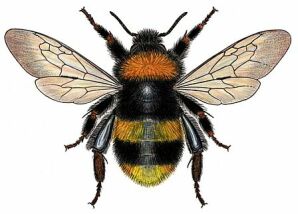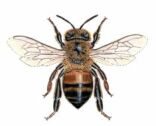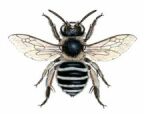Bumblebee
Bumblebees are large, hairy, social bees belonging to the family Apidae (subfamily Bombinae).
Bumblebees are not native to Australia, though the large earth bumblebee Bombus terrestris has become established in Tasmania. Though there have been occasional reports of bumblebees in Victoria, only one report has been confirmed. A single dead bee was detected in inner Melbourne in March 2020; however, follow-up surveillance found no additional suspect bumblebees.
If you think you’ve seen bumblebees in Victoria
If you think you’ve seen bumblebees in Victoria, contact our Customer Service Centre on 136 186.
Provide the following information:
- your name, address, and telephone number
- a description of the insect, including size, colour, general appearance, noise when flying and speed of flight
- the date, time and exact location of the sighting
- habitat, host plant or flower and weather conditions, if possible.
If, from your description, bumblebees are suspected, a technical specialist might contact you to arrange a visit to the location where the sighting occurred.
If you’ve collected an insect and think it's a bumblebee
Warning: Bumblebees can sting multiple times. Do not handle live bees. Only collect bumblebees if you are competent in the collection of stinging insects and it is safe to do so.
If you suspect an insect you’ve collected is a bumblebee, please submit the insect for examination:
- Kill the bee in methylated spirits or ethyl alcohol.
- Place it in a tightly capped glass or plastic tube or jar (but not in a paper envelope).
- Label the container with your name, address, telephone number, and the date, time and exact location where the insect was collected. If possible, include other relevant information such as habitat, host plant or flower, and weather conditions.
- Post it to the following address:
Crop Health Services
Private Bag 15
South Eastern Mail Centre VIC 3176
Appearance of a bumblebee
Although many native bees (Figures 6 and 7) occur in Australia, none resemble bumblebees. The large earth bumblebee (Figures 1 to 3) is hairier and more heavily built than the European honey bee (Figure 4) or the European wasp (Figure 5).








Colour and markings
The large earth bumblebee is black with one yellow or ochre band across the front of the thorax, and another yellow/ochre band across the abdomen. An important identifying feature of the large earth bumblebee is the tip of the abdomen, which is buff or white.
European wasps are bright yellow and black, and less hairy than bumblebees or honey bees.
Size
Large earth bumblebee queens (Figure 1) are 3 0mm to 35 mm in length. They make a loud buzzing sound during flight.
Workers (Figure 3) are highly variable in size, ranging from 8 mm to 22 mm in length. Large earth bumblebee males (Figure 2) are similar in size and appearance to large workers.
In comparison, European honey bee (Apis mellifera) workers are approximately 15 mm long and are dark yellow-orange and black. European wasp (Vespula germanica) workers average around 15 mm long and European wasp queens can be up to 20 mm long.
Potential threat to Victoria
The large earth bumblebee is used commercially overseas to pollinate certain glasshouse and field crops. But in Victoria bumblebees could pose a potential threat to the environment and primary production.
Under the Flora and Fauna Guarantee Act 1988, the introduction and spread of the large earth bumblebee to Victoria has been listed as a ‘potentially threatening process’. Potential impacts include:
- competition with native nectar feeding fauna
- decline in the seed production of native plant species
- increase in the seed production of introduced plants that currently lack an efficient pollinator (often called ‘sleeper weeds’).
Bumblebees can also sting multiple times, although they will generally only do so when physically threatened.
Investigating the impact of bumblebees
Studies are underway in Tasmania to assess the impact of bumblebees on:
- other pollinators
- native plants
- sleeper weeds.
These studies are also investigating the distribution and spread of the large earth bumblebee in Tasmania, and whether pests or pathogens of the bumblebee are present.
In Victoria, we have prepared a Pre-incursion Plan that describes the threat and states what will be done to manage the threat. Since 2022, routine surveillance has been undertaken each bumblebee season using specific lures to trap at key locations. The aim is to ensure early detection. To date, no bumblebees have been detected.
Bringing bumblebees into Victoria
Bumblebees cannot be imported to Australia from other countries. Visit the Department of Agriculture website for information on importing animals to Australia.
Introducing the large earth bumblebee to Victoria from Tasmania may be a breach of the Livestock Disease Control Regulations 2017. Contact our Animal Health Branch on 03 5430 4509 for advice.
Reporting a honey bee pest or disease
Report any unusual pest or disease of honey bees immediately using our online reporting system or by calling the Exotic Plant Pest Hotline on 1800 084 881. Early reporting increases the chance of effective control and eradication.
Please take multiple good quality photos of the pests or symptoms of disease to include in your report where possible, as this is essential for rapid pest and disease diagnosis and response.
Your report will be responded to by an experienced staff member who may seek more information about the detection and explain next steps.
Report nowImage credits
Image collection: Tasmanian Museum and Art Gallery